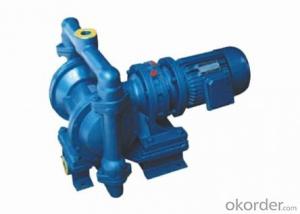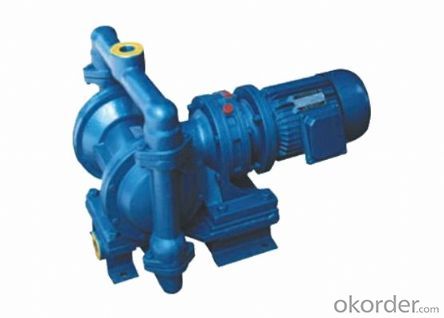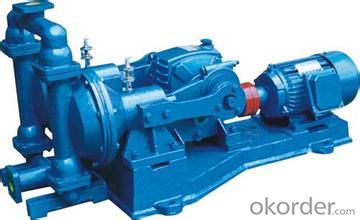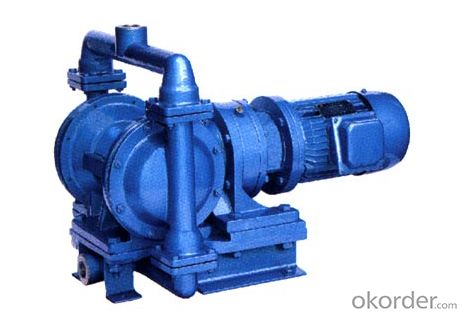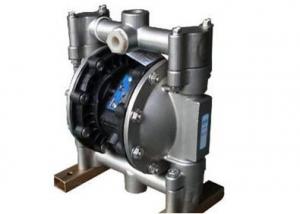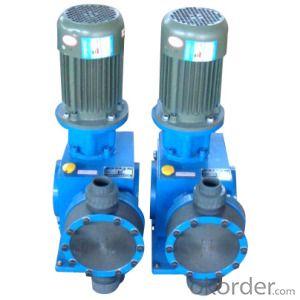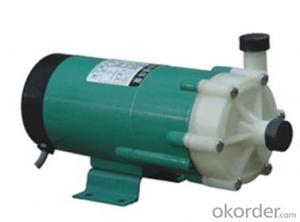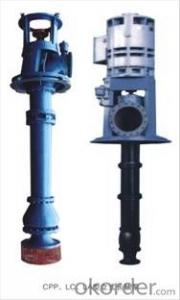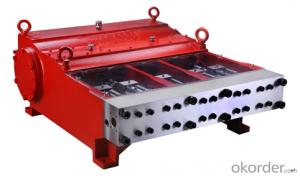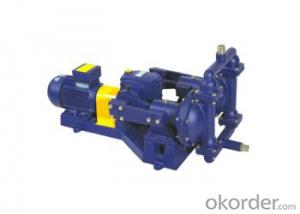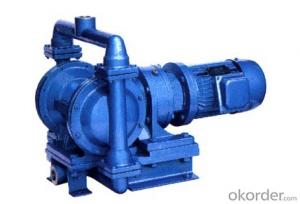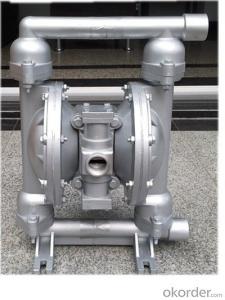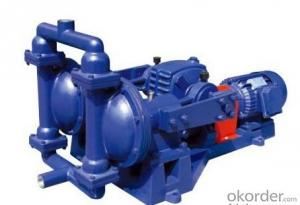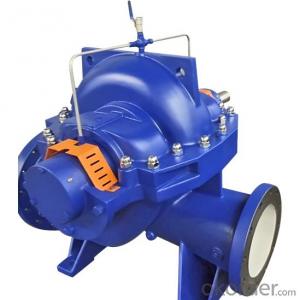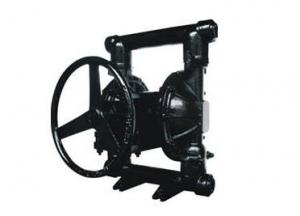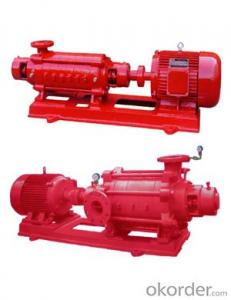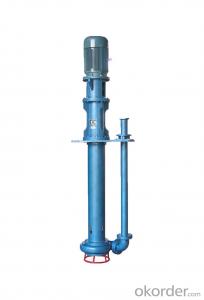DBY series electric operated diaphragm (EOD) pump
- Loading Port:
- Shanghai
- Payment Terms:
- TT OR LC
- Min Order Qty:
- 1 unit
- Supply Capability:
- 500 unit/month
OKorder Service Pledge
OKorder Financial Service
You Might Also Like
DBY series electric operated diaphragm (EOD) pump
Product Description of DBY series electric operated diaphragm (EOD) pump
DBY electric diaphragm pump is a new type of pumps, in recent years, because the diaphragm material made breakthrough progress, the more and more industrialized countries have adopted this type of pump, replacing part of centrifugal pump, screw pump, used in petrochemical industry, ceramic, metallurgy and other industries, DBY electric diaphragm pump suitable for low pressure, namely outlet pressure or less 3 KGF/cm2 occasions. DBY electric diaphragm pump is the factory production of a new type of conveying machinery, the motor through the reducer reduction drive, for all kinds of corrosive liquid, with grain fluid, high viscosity, volatile, flammable and poisonous liquid, all can with suction light suction do.
DBY electric diaphragm pump note: DBY electric diaphragm pump work first open the outlet valve, in the work are prohibited during the outlet valve closed.
Diaphragm materials: neoprene, fluoride rubber, Buna-N rubber and Teflon.
Casing materials: Cast Iron, SS304, SS316, Aluminum, PP, PP lining, PVDF, NBR lining
Usage of DBY series electric operated diaphragm (EOD) pump
All kinds of highly toxic, flammable, volatile liquid.
All kinds of strong acid, strong alkali, strong corrosive liquid.
Can transport 150 ℃ high temperature medium.
As a front-end send pressure device of all kinds of filter press.
Hot water recycling and circulation.
Oil tank truck, oil depot, oil loading and unloading.
Pump suction pickles, jam, mashed potatoes, chocolate, etc.
Pump suction paints, rubber, paint adhesive.
All kinds of porcelain glaze slurry, cement grout, mortar, and mud.
All kinds of rubber paste emulsion, organic solvent, and filler.
Pump for the tanker barge sewage and sit in a clearance from storehouse.
Hops and baking powder slurry, syrup, molasses.
Pump suction sewage in mines, tunnels, tunnels, sewers and sediment.
To transfer all kinds of special medium
Main features of DBY series electric operated diaphragm (EOD) pump
1, DBY electric diaphragm pump does not need to irrigation water diversion, automatic capacity of 7 meters above.
2, through the performance is good, diameter in 10 mm the following particle, mud, etc. Can easily through the.
3, due to the diaphragm will be transported medium and transmission machinery a separate, so medium never to external leakage. And the pump itself without shaft seal, the service life is prolonged greatly. According to the different medium, the diaphragm is divided into chloroprene rubber, fluorine rubber, polybutadience rubber, etc, can satisfy the requirements of different users.
4, pump body medium flows through part, can according to user requirements, divided into cast iron, stainless steel, rubber lining, the motor can be divided into ordinary type and explosion-proof type two kinds.
FAQ
Q: Are CNBM pumps available in DIY stores?
A: Yes, currently, we’re available for DIY stores all over the world.
Q: Where do I have to send pumps for service?
A: You must send them to the CNBM PUMP Service Point or, after contacting Customer Care, to the CNBM PUMP service center in China.
Q: Are your pumps acid-proofed?
A: To choose the right pumps for chemical applications, we do need further details on hydraulic operations as well as on the type, concentration and temperature of the liquid.
Q: Can your pumps mount Eff.1 motors
A: Currently, only on request though this will shortly be a CNBM standard.
Q: Are your pumps protected against dry running?
A: No, unprotected centrifugal pumps are not generally designed for dry running. It is important to give us or your dealer as much information as possible about the system in which the pump is used. Inlet pressure, the type of liquid to be pumped, together with relative density, viscosity and temperature, for example, are required in order to allow CNBM to recommend the right pump with the right gaskets for a long operating lifetime.
- Q: The water sprite I used in the fish tank, they need to connect the air pump, but I have an aerator, I wonder if I can use it What's the difference between the two of them?
- The difference between air pump and aerator is that water depth is used by air pump and shallow water aerator, and its function is the same.The aerator is a driving component of a motor or a diesel engine through the air system, "oxygen" quickly transferred to the aquaculture equipment, it can be integrated with physical, chemical and biological functions, can not only solve the pond because hypoxia caused the fish floating head, but also can eliminate the harmful gas exchange, promote the convection of the water, improve water quality, reduce feed coefficient, improve fish activity and primary productivity, thereby increasing stocking density, increase the intensity of feeding, breeding objects to promote growth, the yield is greatly improved, fully achieve the purpose of increasing farming.Product type aerator is more also, its characteristics and working principle are different, the oxygenation effect difference, the scope is not the same, producers can according to the needs of the dissolved oxygen in different breeding systems, selection of aerator suitable to obtain good economic performance.
- Q: Can an air pump be used for powering air suspension systems?
- Yes, an air pump can be used for powering air suspension systems. Air suspension systems require pressurized air to adjust the ride height and provide a smooth, comfortable ride. An air pump is commonly used to supply the necessary air pressure to the suspension system, ensuring its proper functionality.
- Q: Are air pumps suitable for wastewater aeration?
- Yes, air pumps are suitable for wastewater aeration. Aeration is an essential process in wastewater treatment as it helps to introduce oxygen into the wastewater, promoting the growth of aerobic bacteria that break down organic pollutants. Air pumps, also known as aerators or diffusers, are commonly used to supply the necessary oxygen to the wastewater. These pumps work by forcing air into the water through diffusers, creating bubbles that increase the surface area for oxygen transfer. By supplying oxygen, air pumps support the growth of beneficial microorganisms that aid in the decomposition of organic matter and removal of harmful substances. Furthermore, they help to maintain proper mixing and circulation within the wastewater, preventing the formation of anaerobic zones that can produce foul odors and release toxic gases. Overall, air pumps are an effective and efficient solution for wastewater aeration, contributing to the successful treatment of wastewater and the protection of the environment.
- Q: What's the difference between a filter and an oxygen pump? Can a fish filter be used only?
- The filter is a water pump as the driving force, so that the flow through the filter material, to achieve the purpose of purifying water quality aquarium equipment, common on the filter, side (back) filter, bottom filter, bucket filter, filter. Some filters incorporate oxygen enhancing functions, such as three in one submersible pumps, etc..The oxygen pump is a kind of aquarium equipment that uses air to press air into the water to increase the contact area between water and air and to increase dissolved oxygen in water. General matching pipe, cloth head use.Fish must filter equipment, but not to use the air pump, it is not hypoxia. I don't need two jars. The grass tank produces a lot of oxygen, and it doesn't need it. In the seawater tank, the protein separator is pumped heavily and has enough dissolved oxygen. I have an air pump, which is used only for the hatching of good year shrimps.
- Q: Can an air pump be used for oxygen therapy?
- Using an air pump for oxygen therapy is not possible. Oxygen therapy necessitates the utilization of an oxygen concentrator or an oxygen cylinder, both of which offer a higher oxygen concentration than that found in the surrounding air. An air pump merely circulates air and lacks the ability to concentrate or deliver oxygen at the adequate levels required for oxygen therapy. To ensure the safety and efficacy of oxygen therapy, it is crucial to employ the appropriate equipment recommended by medical experts.
- Q: Are air pumps suitable for inflating air mattresses with built-in frames?
- Yes, air pumps are suitable for inflating air mattresses with built-in frames. Air pumps are designed to inflate various inflatable products, including air mattresses. They provide a quick and efficient way to inflate the mattress, saving time and effort. Air pumps also ensure that the mattress is properly inflated, providing a comfortable sleeping surface. Additionally, most air pumps have different nozzle attachments that can fit different valve types, making them compatible with air mattresses with built-in frames.
- Q: How does an air pump handle different noise reduction features?
- An air pump typically handles different noise reduction features by incorporating various mechanisms and technologies designed to minimize noise production and create a quieter operating environment. One common noise reduction feature is the use of sound baffles or mufflers, which are installed within the air pump to absorb and dissipate noise generated during operation. These baffles or mufflers are often made from materials that can effectively attenuate sound waves, such as foam or rubber. Another noise reduction feature employed by air pumps is the use of anti-vibration mounts or pads. These components help to isolate the pump from its surroundings, reducing the transmission of vibrations that can contribute to noise generation. By minimizing the transfer of vibrations, air pumps can operate more quietly and with less disturbance. In addition, some air pumps may utilize advanced motor technologies, such as brushless DC motors, which are inherently quieter than traditional motors. These motors have fewer moving parts and operate more smoothly, resulting in reduced noise levels. Furthermore, many air pumps incorporate noise-reducing design elements, such as streamlined airflow paths and optimized fan blades. By improving the airflow dynamics and reducing turbulence, these design features help to minimize noise generation. The materials used in the construction of the air pump can also play a role in noise reduction. For instance, using sound-dampening materials and coatings can help to absorb or reflect sound waves, resulting in a quieter operation. Overall, air pumps can handle different noise reduction features by combining a combination of sound baffles, anti-vibration mounts, advanced motor technologies, noise-reducing design elements, and appropriate materials to create a quieter and more pleasant operating experience.
- Q: How does an air pump handle continuous operation?
- An air pump is designed to handle continuous operation by incorporating durable components, such as a robust motor and high-quality bearings, that can withstand the constant usage without overheating or breaking down. Additionally, it may have built-in cooling mechanisms, like a fan or heat dissipation system, to regulate the temperature and prevent any damage due to prolonged operation.
- Q: Are air pumps suitable for inflating air loungers for indoor use?
- Yes, air pumps are suitable for inflating air loungers for indoor use. They provide a convenient and efficient way to quickly inflate and deflate air loungers, making them easy to set up and store when not in use.
- Q: Can an air pump be used for inflating air-filled camping gear?
- An air pump can be utilized to inflate camping gear that is filled with air. This purpose is widely served by air pumps, which come in various types including manual hand pumps, foot pumps, and electric pumps. These pumps are specifically designed to inflate camping gear like air mattresses, inflatable pillows, and inflatable chairs or loungers. They offer a convenient and efficient way to inflate the gear, saving both time and effort. Moreover, certain air pumps are equipped with adapters that can accommodate different valve sizes, making them compatible with a wide range of camping gear. However, it is crucial to ensure that the chosen air pump is suitable for the specific camping gear at hand, as different gear may necessitate different pressure levels or valve types.
Send your message to us
DBY series electric operated diaphragm (EOD) pump
- Loading Port:
- Shanghai
- Payment Terms:
- TT OR LC
- Min Order Qty:
- 1 unit
- Supply Capability:
- 500 unit/month
OKorder Service Pledge
OKorder Financial Service
Similar products
Hot products
Hot Searches
Related keywords
